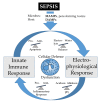Ion and Water Transport in Neutrophil Granulocytes and Its Impairment during Sepsis
- PMID: 33567720
- PMCID: PMC7914618
- DOI: 10.3390/ijms22041699
Ion and Water Transport in Neutrophil Granulocytes and Its Impairment during Sepsis
Abstract
Neutrophil granulocytes are the vanguard of innate immunity in response to numerous pathogens. Their activity drives the clearance of microbe- and damage-associated molecular patterns, thereby contributing substantially to the resolution of inflammation. However, excessive stimulation during sepsis leads to cellular unresponsiveness, immunological dysfunction, bacterial expansion, and subsequent multiple organ dysfunction. During the short lifespan of neutrophils, they can become significantly activated by complement factors, cytokines, and other inflammatory mediators. Following stimulation, the cells respond with a defined (electro-)physiological pattern, including depolarization, calcium influx, and alkalization as well as with increased metabolic activity and polarization of the actin cytoskeleton. Activity of ion transport proteins and aquaporins is critical for multiple cellular functions of innate immune cells, including chemotaxis, generation of reactive oxygen species, and phagocytosis of both pathogens and tissue debris. In this review, we first describe the ion transport proteins and aquaporins involved in the neutrophil ion-water fluxes in response to chemoattractants. We then relate ion and water flux to cellular functions with a focus on danger sensing, chemotaxis, phagocytosis, and oxidative burst and approach the role of altered ion transport protein expression and activity in impaired cellular functions and cell death during systemic inflammation as in sepsis.
Keywords: NADPH oxidase; NHE1; calcium; cell death; chemotaxis; intracellular pH; neutrophil granulocytes; sepsis.
Conflict of interest statement
The authors declare no conflict of interest.
Figures


References
-
- Morriello F. Neutrophils and Inflammation: Unraveling a New Connection. Biol. Med. 2016:8. doi: 10.4172/0974-8369.1000325. - DOI
Publication types
MeSH terms
Substances
Grants and funding
LinkOut - more resources
Full Text Sources
Other Literature Sources
Medical
Miscellaneous

